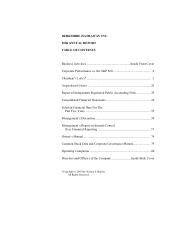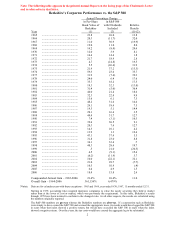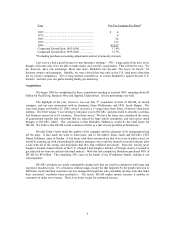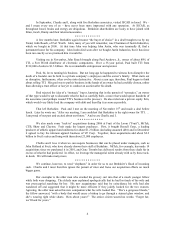Berkshire Hathaway 2006 Annual Report Download - page 9
Download and view the complete annual report
Please find page 9 of the 2006 Berkshire Hathaway annual report below. You can navigate through the pages in the report by either clicking on the pages listed below, or by using the keyword search tool below to find specific information within the annual report.
Below is the tally on our underwriting and float for each major sector of insurance. Enjoy the
view, because you won’ t soon see another like it.
(in $ millions)
Underwriting Profit (Loss) Yearend Float
Insurance Operations 2006 2005 2006 2005
General Re ....................... $ 526 $( 334) $22,827 $22,920
B-H Reinsurance.............. 1,658 (1,069) 16,860 16,233
GEICO ............................. 1,314 1,221 7,171 6,692
Other Primary................... 340** 235* 4,029 3,442
Total................................. $3,838 $ 53 $50,887 $49,287
* Includes MedPro from June 30, 2005.
** Includes Applied Underwriters from May 19, 2006.
* * * * * * * * * * * *
In 2007, our results from the bread-and-butter lines of insurance will deteriorate, though I think
they will remain satisfactory. The big unknown is super-cat insurance. Were the terrible hurricane seasons
of 2004-05 aberrations? Or were they our planet’ s first warning that the climate of the 21st Century will
differ materially from what we’ ve seen in the past? If the answer to the second question is yes, 2006 will
soon be perceived as a misleading period of calm preceding a series of devastating storms. These could
rock the insurance industry. It’ s naïve to think of Katrina as anything close to a worst-case event.
Neither Ajit Jain, who manages our super-cat operation, nor I know what lies ahead. We do know
that it would be a huge mistake to bet that evolving atmospheric changes are benign in their implications
for insurers.
Don’ t think, however, that we have lost our taste for risk. We remain prepared to lose $6 billion
in a single event, if we have been paid appropriately for assuming that risk. We are not willing, though, to
take on even very small exposures at prices that don’ t reflect our evaluation of loss probabilities.
Appropriate prices don’ t guarantee profits in any given year, but inappropriate prices most certainly
guarantee eventual losses. Rates have recently fallen because a flood of capital has entered the super-cat
field. We have therefore sharply reduced our wind exposures. Our behavior here parallels that which we
employ in financial markets: Be fearful when others are greedy, and be greedy when others are fearful.
Lloyd’s, Equitas and Retroactive Reinsurance
Last year – we are getting now to Equitas – Berkshire agreed to enter into a huge retroactive
reinsurance contract, a policy that protects an insurer against losses that have already happened, but whose
cost is not yet known. I’ ll give you details of the agreement shortly. But let’ s first take a journey through
insurance history, following the route that led to our deal.
Our tale begins around 1688, when Edward Lloyd opened a small coffee house in London.
Though no Starbucks, his shop was destined to achieve worldwide fame because of the commercial
activities of its clientele – shipowners, merchants and venturesome British capitalists. As these parties
sipped Edward’ s brew, they began to write contracts transferring the risk of a disaster at sea from the
owners of ships and their cargo to the capitalists, who wagered that a given voyage would be completed
without incident. These capitalists eventually became known as “underwriters at Lloyd’ s.”
Though many people believe Lloyd’ s to be an insurance company, that is not the case. It is
instead a place where many member-insurers transact business, just as they did centuries ago.
Over time, the underwriters solicited passive investors to join in syndicates. Additionally, the
business broadened beyond marine risks into every imaginable form of insurance, including exotic
coverages that spread the fame of Lloyd’ s far and wide. The underwriters left the coffee house, found
grander quarters and formalized some rules of association. And those persons who passively backed the
underwriters became known as “names.”
8






















